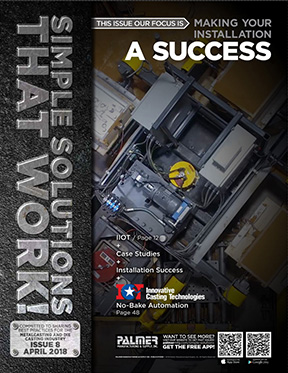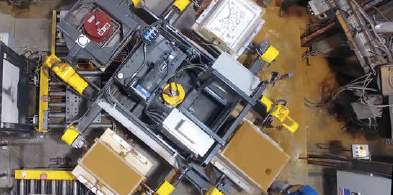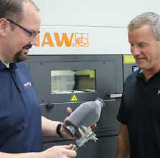Foundry & industrial processing Machinery EQUIPMENT & SYSTEMS
U.S. & Canada Call 1.800.457.5456
Bold Installation of No-Bake Automation
Home Articles Bold Installation of No-Bake Automation

Simple Solutions That Work!™, Volume 9, September 2018
Written - Jack Palmer.
Jack Palmer
President
Palmer Manufacturing & Supply, Inc.
Article Takeaways:
Innovative Castings Dualtech Foundry is one of North America’s premier prototype casting facilities. ICT Dualtech has the ability to receive a casting model, run it through their solidification program, cut cope and drag patterns / core boxes, make castings and fully machine all on the same campus. ICT does this while meeting the delivery requirements of the top names in the large equipment arena, including Caterpillar, Cummins and Deere – which can be in as little as two weeks.
This company has never been shy to venture out of the box to try something new. Whereas others take the ‘if it ain’t broke, don’t fix it’ model, ICT takes a different approach that has served this leading company well.
ICT approaches all of its projects with the goals to increase production, reduce waste, decrease lead times and improve quality. It’s an approach of continuous improvement and being open to more advanced technologies to accomplish their mission.
While they were always quite busy and profitable, the owner Jack Laugle saw an oncoming surge of casting production requirements due to the improving economy.
While their normal no-bake production equipment was effective and productive Laugle and his foundry manager Brian Claycamp wanted to increase output without increasing the building square footage and have zero downtime due to equipment installation, and commissioning.
Palmer had been a long time equipment supplier to ICT Dualtech and has been with them through their many growth steps. Laugle began this business as a small patternmaker and now has a campus complete with pattern making, machining, foundry, plastic pattern printing, and new this year is 3D metal printing, as an additional prototype and production option for his customers.
Palmer presented a pretty revolutionary idea that would increase production on variable sized castings with a new, and first-of-a-kind Flip Molding Machine (FMM).
The Palmer engineering team met with the ICT Dualtech staff to determine all of the important production requirements, delivery time, and space limitations which eliminated the possibility of adding a carousel or a traditional conveyor / rollover based system.
The automated solution that fit this bill was a new innovation: instead of traditional slow, and expensive large rollover to remove the mold from the box, the platen that held the mold box would invert and then the mold would be drawn out onto a precision lift where the conveyor on top of the lift would move the mold half outboard of the machine for traditional coating, coring, closing, and clamping procedures.
Laugle saw that the FMM offered more than a high mold production rate, all without an expensive rollover. The FMM also offered a flexible production opportunity which was critical. As production varies, this machine accommodates that easily.


INNOVATIVE CASTINGS – 3D METAL PRINTING
Innovative Castings is a complete in-house foundry. All patterns, pouring, post foundry processing and machining is completed in their sprawling campus. Recently added is a new building that houses their 3D metal & plastic printing. Along with this they also make fixturing and machine prototypes from solid billets. They are currently providing metal & plastic 3D printed parts and prototypes to die casters, foundries, especially in automotive, aerospace and medical markets. For die casters and injection molders, metal mold tools contain channels to cool the mold. With conventional tool making methods, these cooling channels are drilled into the tool in straight lines. Metal additive manufacturing allows cooling channels to be designed and built to perfectly contour the mold. This technology is referred to as Conformal Cooling. This technology helps to improve cooling performance, increase cycle time, extend the life of the mold and reduce waste. www.innovative-castings.com
The foundry industry is an old industry and not one to easily add new automation that they had never seen before. Laugle does not fit this old stereotype
As with all system installations, communication and planning is critical - no detail is too small. Once the molding machine concept was determined, there were many decisions to make and lots of information to gather.
FOR THIS PROJECT NECESSITIES WERE:
- Upgrade the existing mixer from 300-600 lb per minute.
- Add the latest technology in sand/resin/reporting technology using a 3-part PUNB system.
- Plan on the removal of the existing manual line, compaction table, wiring, plumbing, gas lines, air lines, Ethernet cabling, etc.
- Schedule the removal of old equipment with the arrival of the new equipment (Transition space wasn’t available and the cost of rented equipment needed to be as low as possible.)
- Prewire and preplumb as much as possible while running the existing system layout and prepare the mold discharge conveyor, and move the existing mold closing crane to the new position.
- Add a transfer car and conveyor from the existing carousel/rollover based system to allow for closed molds from the UMM to go to the existing pouring/cooling system transfer car.
- Determine that all equipment would be guarded anywhere it was close to personnel and fork lift traffic.
- Ensure all wiring/plumbing/mounting/rigging components were on the floor since this was to be a 3-day weekend install.
- Schedule outside electrical and mechanical contractors.

FOR THIS PROJECT NECESSITIES WERE:
This planning required twice weekly meetings both at ICT Dualtech as well as with the engineering staff at Palmer for almost a month before the first FMM machine part was made.
Once the machine conceptual design was finalized and the schedule set for manufacturing and delivery, there were weekly meetings with the engineering staff, the foundry manager, maintenance manager, and the production supervisor.
At all meetings, everyone’s opinion was as valuable as anyone else’s. In this project, the opinions of the floor personnel were taken very seriously. Engineers can design and process/ operations people can plan and sequence, but the floor people live with the equipment and systems every day, all day and many times have valuable common sense ideas.
The basic mechanical structure was quickly established. The programming required a great deal of effort, planning and testing. Each customer’s unique needs requires hours of discussion and planning and a thorough review process even for production equipment that has been made many times in the past.
PRODUCTION RUNOFF TEST
Once the machine was up and running, a full scale production runoff test was specified. This is always an excellent idea, if possible, depending on timing, system size, and budget. In the world of custom designed machinery and systems, there are almost always unforeseen situations. If a full scale runoff can be performed, most if not all of these can be identified, addressed, and corrected. Then, another full scale runoff can be performed if possible.
For this particular customer, 3 separate full scale runoffs were performed. Even with hundreds of hours of planning and discussion, there were customer driven additions and changes once they saw the physical machine running, which is pretty predictable with a project of this size.
While full scale runoffs are expensive and time consuming, the time is well spent. If changes and additions are needed in the field after installation, not only is it cumbersome and expensive to make these changes and additions (especially if the distance between the manufacturer and the customer is great), but production comes to a halt.
Once the final runoff was finished and all changes and additions were made, the install weekend was selected and all personnel informed: trucking/millwrights/mechanical contractors/internal personnel both at ICT Dualtech and Palmer. The plan was to tear out on Friday and place the new equipment Friday afternoon, mount/grout/wire plumb Saturday and Sunday with an initial production run on the following Monday.
The system was operational ahead of schedule on Sunday evening. Once the customer saw the speed of the system, there were some additional changes/additions made.
The system was designed at 20 complete molds/40 mold halves per hour. This rate was achieved Tuesday. The next 2 weeks were spent tweaking timers, conveyors, and training operations personnel to increase speed. Of these 4 items, changing the operators’ perception of production was the most difficult. People resist change and therefore, it took some time to change their outlook from the existing 12 mold per hour mentality to what eventually became 40 complete molds per hour! When this rate of production was reached, processes are much different. Sand temperature control is critical and pumping system accuracy is critical.
30-40 cope/drag pattern changes per day are not uncommon therefore tools and procedures were put in place to make pattern changes as close to “in cycle” as possible. “In cycle” is defined as making the pattern change without changing production cycle time with an hourly production rate of 80. This equates to an available window of only 45 seconds. With safety in mind it is necessary to perform LOTO (Lock Out Tag Out) remove 4 bolts, remove the pattern on the supplied tramrail, move the new box into place, replace 4 bolts, and reverse LOTO with 2 motivated operators. This sometimes can be performed in cycle; if not, it rarely exceeds 90 seconds.
After the molds are produced, they move to a traditional conveyor based line where coating is applied and torched (if needed), cores carefully placed, the cope is lifted and vents drilled, blown out, and carefully placed on the drag. But again, ICT Dualtech is unique in that the molds are 1 in 1 out. That is to say the mold halves are not moved to a staging or accumulating line where they are assembled as the operators see fit.
With the 45 second per half rate, there are only 90 seconds to perform the above operations. However, with careful planning, good tools, great communication, efficient delivery of good cores to the closing area, this rate is achieved hour after hour and day after day.
With the previous (and still existing) carousel / rollover system it took 3 operators about 10+ hours to produce the full floor quantity of 140 molds. With the newly installed Flip Molding System, the floor is filled in 3 1/2 hours with the same 3 operators.
This system went from concept to engineering/manufacturing/runoff /shipment in a little over 90 days. Installation took 4 days to achieve production operational status at the designed rate of 20 molds per hour. This 4 day time frame is exceptional by any measure but is achievable with careful planning and excellent communication. While the designed production rate was achieved the first week of operation, it took about 4-5 weeks to get to 35; once 35 was reached, it was determined that box fill time was the last step to increase the production rate. The mixer flow rate was increased to the point where a full 40 molds per hour is a daily occurrence. In keeping with ICT’s continuing improvement mindset, there have been a number of additions and changes mostly to the reporting side of the program. There is now a running 5 mold average production speed that is displayed on the Home HMI screen and sand and resin usage can be tracked along with a number of other items being monitored by both management and floor production personnel.
- going out of the box, Laugle saw these key benefits:
- Production rates never seen before with a no-bake automated molding system anywhere in North America.
- Cost reduction from not using a comparably sized rollover. The cost of the FMM was determined to actually be less than a rollover by itself with the obviously huge advantage that the FMM is a complete molding system by itself.
- Additional daylight is essentially unlimited.
- No special foundation or pit was required which makes installation quick and easy, but also makes the system portable if building changes are made or if it is determined that the system would be more productive in another location.
- Greatly reduced labor costs. In this instance, the previous rate was 35 labor hours for 140 molds. With the FMM, this was reduced to 10.5 hours – a labor savings of over 300%!
As a result of ongoing excellent management and business practices in general and the obvious success of the FMM in particular, ICT Dualtech is now in talks with Palmer for another foundry with larger size capacity.
Copyright © 2025 Palmer Manufacturing & Supply, Inc. | Terms and Conditions | Privacy Policy




